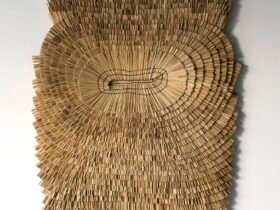ALBUQUERQUE — Where is the voice of the artist in the museum? This question was asked during an artists’ roundtable discussion during the opening weekend of the exhibition Broken Boxes: a decade of art, action and dialogueis partly answered by the exhibition itself.
Over the past 10 years Broken Boxes Podcast has transferred ideas between artists thanks to its creator, Ginger Dunnill, who also served as co-curator Broken boxes. The show features large-scale artworks, installations, videos and performances by 23 artists, many of whom are friends with each other and Dunnill. They have all contributed to the podcast, which covers topics such as mental and physical health, Indigenous sovereignty, settler colonialism, migration and navigating the commercial art market. Directional speakers located throughout the exhibition space play excerpts from podcast episodes, creating an ambient soundtrack for the show; visitors can listen while being near works by the artists whose voices they hear.

One of those voices is that of Autumn Chacon, a Diné and Chicana sound artist and activist. Her installation ‘Between Our Mother’s Voice and Our Father’s Ear’ (2016) is a long-term, unlicensed radio broadcast that incorporates sounds from the exhibition, mixed with field recordings and excerpts from the Broken Boxes Podcast. Chacon, who uses sound art as a form of resistance, turned her focus to ownership breakdown and coercive regulation after working at the licensed broadcaster. In Broken boxessome of her ideas about the power of occupying airwaves – for example the fact that speech is a vibration that cannot be undone – are made visible through a spring microphone whose cable runs in a wave pattern along the length of a central gallery wall.
Sound as a catalyst for personal and collective transformation also appears in other works, including Marie Watt’s grouping of tactile, tactile jingle clouds, and Guadalupe Maravilla’s mixed media sculpture “Disease Thrower #17” (2021), against the backdrop of the “Tripa Chuca ( mural)” by the artist (2024). The installation consists of three towering figurative metal rod sculptures with hexagonal upper and lower parts framing gongs, accented with fibrous materials such as wood, cotton and loofah. Maravilla’s practice, rooted in activism and healing, is based on his experiences with stage III colon cancer and references his experiences migrating from El Salvador to the US as a child due to the Salvadoran Civil War. The artist followed that route ritually and collected objects that he incorporated into ‘Disease Thrower #17’, which he activates as healing portals during sound bath ceremonies.

Additional locations of vocal or otherwise audible transformation are present in Black Belt Eagle Scout’s music videos “Spaces” (2023) and “My Blood Runs Through this Land” (2023), and the short film “A Map to the Next World” Joy Harjo. 2023). The generative potential of connection to the land and material changes are evident in Christine Howard Sandoval’s ‘Ignition Pattern’ drawings, made of fire, water, soot and fiber, and in Jeremy Dennis’s drawings. Mom’s house (2020), for which the artist transformed his parental home into a communal art space.
Since I saw the performance, I have been thinking of two works in particular. In ‘Original Fragment of the Lost Girls Treasure Map’ (2024), Amaryllis R. Flowers shows a sugary-sweet, pastel-colored topographical map full of mountains, fields and streams, populated by processions of disembodied legs and high-heeled feet that weave their way through glittering puffy paint, gemstones and other craft materials. Good Girl Swamps, a murky body of water just a stone’s throw from Behavior Islands, is sandwiched between the Astral Plane and Shadowlands, and surrounded by Unchartered Waters, Fringes of (Inner) Hell, Princess Portal, and Foundation of Proof. I listened to Flowers’ projected recording, which discussed the relationship between fantasy and trauma in her work, and I described a time in her life when art was no longer her anchor, but rather her fear. She had suffered a psychotic break, brought on in part by her graduation from Yale and the increasing pressure and turbulence that came with being a “successful” artist after graduating from Yale’s prominent MFA program. “Acts of imagination under unbearable living conditions help us evolve,” she says.

Transgender artist Cassils also refers to such conditions in their work, “The Resilience of the 20%” (2016). The title points to a 20% increase in the number of murders of transgender people worldwide in 2012 compared to previous years. Installed in Broken boxes is a nearly two-ton bronze cast of the clay slab that the artist, who incorporates bodybuilding into his practice, pounded during his “Becoming an Image” performance (not part of the show).
Broken Boxes: a decade of art, action and dialogue amplifies the voices of artists in ways that contradict the narratives promoted by much of the mainstream art world. Here, artists share stories about their lives and experiences rather than relying solely on institutional didactics to explain what their work is about; they ask for help and encourage others to do the same; they engage in slow watching and listening; they push back, create change and break free. They indeed speak truth to power. Actions like these and projects like Broken boxes are crucial, and not just at a time when our constitutional rights and fundamental freedoms are on the chopping block. Words have power, and there is so much more to say.





Broken Boxes: a decade of art, action and dialogue continues at the Albuquerque Museum (2000 Mountain Road Northwest, Albuquerque, New Mexico) through March 2, 2025. The exhibition was curated by Ginger Dunnill and Josie Lopez.













Leave a Reply